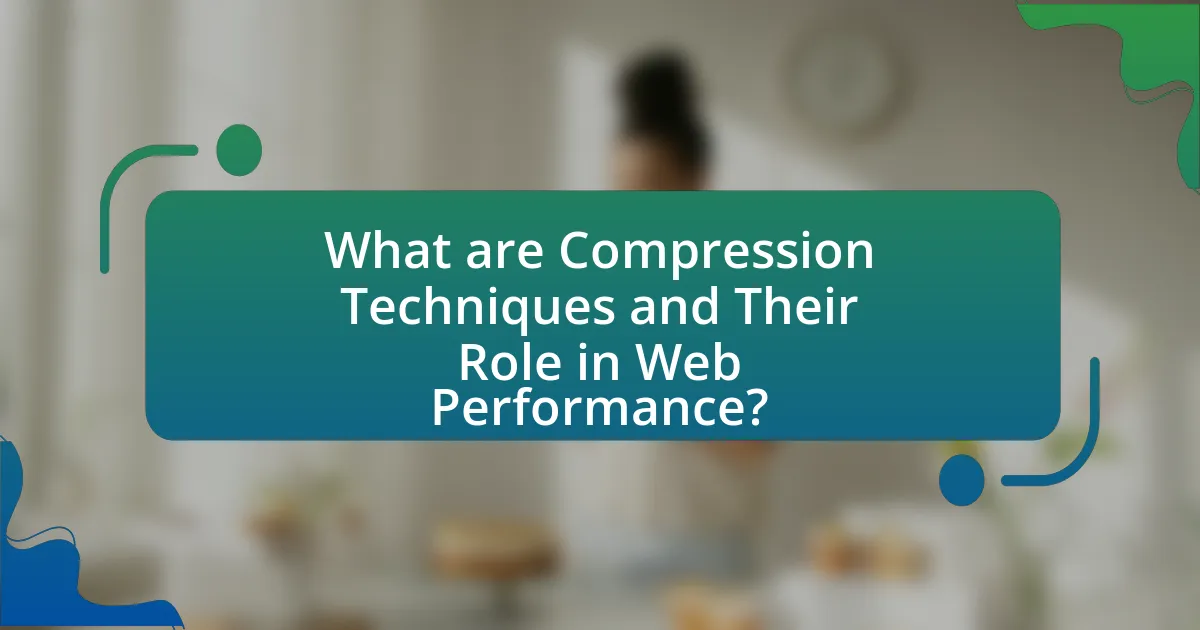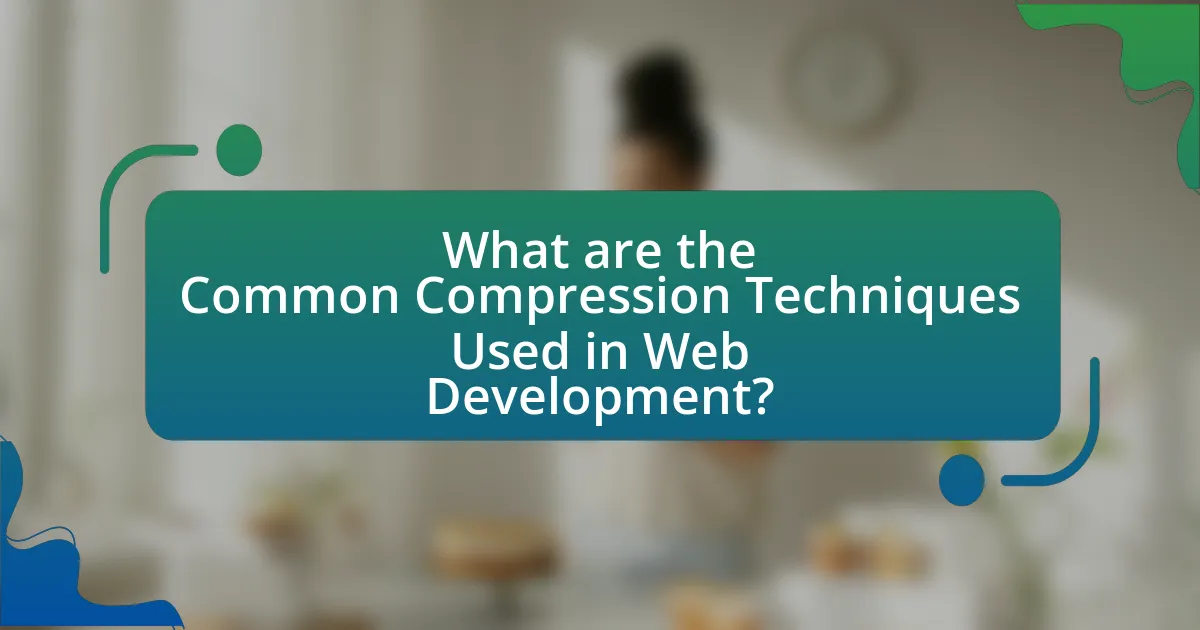Compression techniques are essential methods for reducing file sizes and improving web performance by decreasing load times and bandwidth usage. This article evaluates the effectiveness of various compression algorithms, such as Gzip and Brotli, and their impact on web performance metrics like page load time and user engagement. It discusses the types of data that can be compressed, the differences between lossless and lossy compression, and the importance of selecting appropriate algorithms for optimal results. Additionally, the article highlights best practices for implementing compression techniques, the challenges faced during implementation, and strategies for monitoring and adjusting compression settings to enhance overall web performance.

What are Compression Techniques and Their Role in Web Performance?
Compression techniques are methods used to reduce the size of files and data transmitted over the web, enhancing web performance by decreasing load times and bandwidth usage. These techniques, such as Gzip and Brotli, work by eliminating redundant data and applying algorithms to compress content before it is sent to users’ browsers. For instance, Gzip can reduce file sizes by up to 70%, significantly improving page load speed and user experience. Studies have shown that faster loading times correlate with lower bounce rates and higher user engagement, reinforcing the importance of compression techniques in optimizing web performance.
How do compression techniques work to enhance web performance?
Compression techniques enhance web performance by reducing the size of files transmitted over the internet, which decreases load times and bandwidth usage. When web content, such as HTML, CSS, and JavaScript files, is compressed using algorithms like Gzip or Brotli, the data is encoded in a more efficient format, allowing for faster transfer rates. For example, Gzip can reduce file sizes by 70-90%, significantly improving the speed at which a webpage loads. This reduction in size leads to quicker rendering times in browsers, enhancing user experience and potentially improving search engine rankings due to lower bounce rates.
What types of data can be compressed using these techniques?
Data types that can be compressed using these techniques include text files, images, audio files, and video files. Text files, such as HTML, CSS, and JavaScript, can be effectively compressed using algorithms like Gzip, which reduces file size by eliminating redundant characters. Images, including JPEG and PNG formats, benefit from lossy and lossless compression techniques, respectively, to minimize storage space while maintaining quality. Audio files, such as MP3 and WAV, utilize compression methods to reduce file size without significantly affecting sound quality. Video files, including MP4 and AVI formats, employ compression techniques to decrease file size for efficient streaming and storage. These compression methods are widely recognized for enhancing web performance by reducing load times and bandwidth usage.
How do different compression algorithms compare in terms of efficiency?
Different compression algorithms vary significantly in efficiency, with lossless algorithms like Gzip and Brotli typically achieving better compression ratios than lossy algorithms such as JPEG and MP3 for specific data types. Gzip, for instance, can reduce file sizes by approximately 70% for text-based files, while Brotli can achieve even higher compression ratios, particularly for web assets, often exceeding 80%. In contrast, lossy algorithms prioritize speed and reduced file size over fidelity, making them more suitable for media files. The efficiency of these algorithms is often measured by their compression speed and the time taken to decompress, with Brotli being slower to compress but faster to decompress compared to Gzip, which is faster in both aspects but less efficient in terms of compression ratio.
Why is evaluating the effectiveness of compression techniques important?
Evaluating the effectiveness of compression techniques is important because it directly impacts web performance, user experience, and resource utilization. Effective compression reduces file sizes, leading to faster load times and lower bandwidth consumption, which is critical for optimizing web applications. Studies have shown that improved compression can decrease page load times by up to 50%, significantly enhancing user satisfaction and engagement. Furthermore, efficient compression techniques can reduce server load and operational costs, making them essential for maintaining high-performance web environments.
What metrics are used to measure web performance improvements?
Metrics used to measure web performance improvements include page load time, time to first byte (TTFB), first contentful paint (FCP), and total blocking time (TBT). Page load time quantifies how long it takes for a webpage to fully load, while TTFB measures the time taken for the server to respond to a request. FCP indicates the time it takes for the first piece of content to appear on the screen, and TBT assesses the amount of time that a page is blocked from responding to user input. These metrics are essential for evaluating the effectiveness of compression techniques, as they directly reflect user experience and site efficiency. For instance, studies show that reducing page load time by just one second can lead to a 7% reduction in conversions, highlighting the importance of optimizing these metrics for improved web performance.
How do compression techniques impact user experience and loading times?
Compression techniques significantly enhance user experience and reduce loading times by minimizing the size of data transmitted over the internet. When web content is compressed, it decreases the amount of data that needs to be downloaded, leading to faster page loads. For instance, studies show that using Gzip compression can reduce file sizes by up to 70%, which directly correlates with improved loading speeds and a more responsive user interface. Faster loading times contribute to lower bounce rates and higher user satisfaction, as users are more likely to stay on a site that loads quickly.

What are the Common Compression Techniques Used in Web Development?
Common compression techniques used in web development include Gzip, Brotli, and Deflate. Gzip is widely adopted due to its balance of compression speed and efficiency, reducing file sizes by up to 70% in many cases. Brotli, developed by Google, offers better compression ratios than Gzip, particularly for text-based files, and is increasingly supported by modern browsers. Deflate is another technique that combines LZ77 and Huffman coding, often used in conjunction with Gzip. These techniques enhance web performance by decreasing load times and bandwidth usage, which are critical for user experience and SEO.
What are the differences between lossless and lossy compression?
Lossless compression retains all original data, while lossy compression reduces file size by permanently eliminating some data. Lossless formats, such as PNG and FLAC, ensure that the original file can be perfectly reconstructed, making them ideal for text and high-quality audio. In contrast, lossy formats like JPEG and MP3 sacrifice some fidelity for smaller file sizes, which is often acceptable for images and music where slight quality loss is not noticeable to the average user. The choice between these two types of compression depends on the specific needs for quality versus file size in web performance contexts.
How does lossless compression maintain data integrity?
Lossless compression maintains data integrity by ensuring that the original data can be perfectly reconstructed from the compressed data without any loss of information. This is achieved through algorithms that identify and eliminate redundancy in the data while preserving all original details. For example, techniques such as Huffman coding and Run-Length Encoding systematically encode data in a way that allows for exact recovery. Studies have shown that lossless compression methods are essential in applications like text files and certain image formats (e.g., PNG), where any loss of data would result in a degradation of quality or functionality.
What are the trade-offs of using lossy compression?
Lossy compression reduces file size by permanently eliminating some data, which results in trade-offs between quality and storage efficiency. While it significantly decreases the amount of data needed for storage and transmission, this method can lead to noticeable degradation in audio, image, or video quality, especially at higher compression rates. For instance, JPEG images may lose fine details, and MP3 audio files may exhibit artifacts, impacting user experience. The balance between acceptable quality loss and file size reduction is crucial; studies show that a 50% reduction in file size can lead to a 10-20% decrease in perceived quality, highlighting the importance of selecting appropriate compression levels based on the intended use.
Which specific compression methods are widely adopted in web performance optimization?
The specific compression methods widely adopted in web performance optimization include Gzip, Brotli, and Deflate. Gzip is commonly used due to its balance of compression speed and efficiency, achieving significant size reduction for text-based files like HTML, CSS, and JavaScript. Brotli, developed by Google, offers better compression ratios than Gzip, particularly for static content, making it increasingly popular for modern web applications. Deflate, which combines LZ77 and Huffman coding, is also utilized but is less common than the other two methods. These methods are validated by their widespread implementation in web servers and browsers, with Gzip being supported by over 90% of web servers and Brotli being adopted by major browsers for improved loading times.
What is Gzip and how does it function?
Gzip is a file compression format and software application used to reduce the size of files for faster transmission over the internet. It functions by employing the DEFLATE algorithm, which combines LZ77 compression and Huffman coding to efficiently compress data. When a server sends a file to a client, Gzip compresses the file before transmission, significantly decreasing the amount of data sent over the network. This reduction in file size leads to faster load times and improved web performance, as studies have shown that Gzip can reduce file sizes by up to 70%.
How does Brotli compare to Gzip in terms of performance?
Brotli outperforms Gzip in terms of compression efficiency and speed for web content. Brotli achieves a higher compression ratio, typically reducing file sizes by 15-25% more than Gzip, which translates to faster load times and reduced bandwidth usage. This efficiency is particularly evident in static assets like HTML, CSS, and JavaScript, where Brotli can compress files more effectively due to its advanced algorithm that utilizes context modeling and Huffman coding. Studies have shown that Brotli can improve page load times by up to 20% compared to Gzip, making it a preferred choice for modern web applications.

How Can the Effectiveness of Compression Techniques be Evaluated?
The effectiveness of compression techniques can be evaluated through metrics such as compression ratio, decompression speed, and impact on web performance. Compression ratio measures the size reduction achieved by the technique, calculated by comparing the original file size to the compressed file size. Decompression speed assesses how quickly data can be restored to its original form, which is crucial for user experience. Additionally, evaluating the impact on web performance involves analyzing load times and bandwidth usage before and after applying compression techniques. Studies, such as those conducted by the W3C, show that effective compression can lead to significant reductions in load times, enhancing overall user satisfaction and engagement.
What tools and methodologies are available for evaluating compression effectiveness?
Tools and methodologies available for evaluating compression effectiveness include benchmarking tools, performance analysis software, and statistical methods. Benchmarking tools like Google PageSpeed Insights and GTmetrix provide metrics on load times and resource sizes before and after compression. Performance analysis software such as WebPageTest allows for detailed assessments of how compression impacts various performance indicators, including Time to First Byte (TTFB) and overall page load time. Statistical methods, including A/B testing, can be employed to compare user experience and engagement metrics between compressed and uncompressed content. These tools and methodologies collectively enable a comprehensive evaluation of compression effectiveness in enhancing web performance.
How do performance testing tools measure the impact of compression?
Performance testing tools measure the impact of compression by analyzing metrics such as load time, response size, and throughput before and after compression is applied. These tools typically simulate user interactions and record the time taken to load resources, allowing for a direct comparison of performance metrics. For instance, tools like Apache JMeter and LoadRunner can provide detailed reports that show how compression reduces the size of data transferred, which in turn decreases load times. Studies have shown that enabling compression can reduce file sizes by up to 70%, significantly improving web performance and user experience.
What role does A/B testing play in evaluating compression techniques?
A/B testing plays a critical role in evaluating compression techniques by allowing direct comparison of user experience and performance metrics between different compression methods. This method involves serving two versions of a webpage—one with a specific compression technique applied and the other without—to a similar audience segment. By analyzing key performance indicators such as load time, page size, and user engagement, A/B testing provides empirical data on the effectiveness of each compression technique. For instance, a study by Google demonstrated that optimizing image compression can reduce load times by up to 50%, significantly improving user retention and satisfaction. Thus, A/B testing serves as a robust framework for determining the most effective compression strategies to enhance web performance.
What are the common challenges faced when implementing compression techniques?
Common challenges faced when implementing compression techniques include balancing compression ratio with processing time and ensuring compatibility across different platforms and devices. High compression ratios can lead to increased CPU usage, which may negatively impact performance, especially on resource-constrained environments. Additionally, not all browsers or devices support the same compression algorithms, leading to potential inconsistencies in user experience. According to a study by the Internet Engineering Task Force, approximately 30% of users may experience issues with unsupported compression formats, highlighting the importance of compatibility in implementation.
How can compatibility issues with browsers affect compression effectiveness?
Compatibility issues with browsers can significantly reduce compression effectiveness by preventing the proper interpretation and utilization of compressed data formats. Different browsers may support varying levels of compression algorithms, such as Gzip or Brotli, leading to inconsistent performance across platforms. For instance, if a browser does not support a specific compression method, it may fall back to uncompressed data, resulting in larger file sizes and slower load times. Studies have shown that browsers like Internet Explorer have historically lagged in supporting modern compression techniques compared to their counterparts, which can lead to a noticeable decrease in web performance metrics such as page load speed and resource efficiency.
What are the potential pitfalls of over-compressing data?
Over-compressing data can lead to significant loss of information and reduced data integrity. When data is excessively compressed, essential details may be discarded, resulting in artifacts or corruption that can hinder usability. For instance, lossy compression techniques, such as JPEG for images, can degrade quality to the point where the visual content becomes unrecognizable. Additionally, over-compression can increase the time required for decompression, negatively impacting web performance and user experience. Studies have shown that excessive compression can lead to longer loading times, which can deter users and affect site engagement metrics.
What best practices should be followed for optimizing compression techniques?
To optimize compression techniques, it is essential to implement several best practices. First, selecting the appropriate compression algorithm, such as Gzip or Brotli, can significantly enhance performance; Brotli, for instance, offers better compression ratios for text files compared to Gzip. Second, configuring server settings to enable compression for all suitable file types, including HTML, CSS, and JavaScript, ensures that the maximum amount of data is compressed before transmission. Third, regularly testing and monitoring the impact of compression on load times and server performance is crucial; studies show that effective compression can reduce page load times by up to 70%. Lastly, avoiding over-compression, which can lead to increased CPU usage and slower response times, is vital for maintaining optimal performance.
How can developers ensure optimal settings for compression algorithms?
Developers can ensure optimal settings for compression algorithms by conducting thorough testing and benchmarking under various conditions. This involves analyzing the trade-offs between compression ratio, speed, and resource usage, which can be achieved through tools like Google PageSpeed Insights or WebPageTest. For instance, a study by the University of Illinois found that adjusting the compression level in Gzip can reduce file sizes by up to 70% without significantly impacting load times, demonstrating the importance of fine-tuning settings based on specific use cases. Additionally, developers should monitor real-time performance metrics to adapt settings dynamically, ensuring that the chosen compression method aligns with the overall web performance goals.
What are the recommended strategies for monitoring and adjusting compression settings?
The recommended strategies for monitoring and adjusting compression settings include utilizing performance monitoring tools, analyzing server response times, and conducting regular audits of resource sizes. Performance monitoring tools, such as Google PageSpeed Insights and GTmetrix, provide insights into how compression affects load times and overall performance. Analyzing server response times helps identify bottlenecks that may arise from improper compression settings, while regular audits of resource sizes ensure that files are adequately compressed without compromising quality. These strategies are essential for optimizing web performance and ensuring that compression settings are effectively enhancing user experience.



